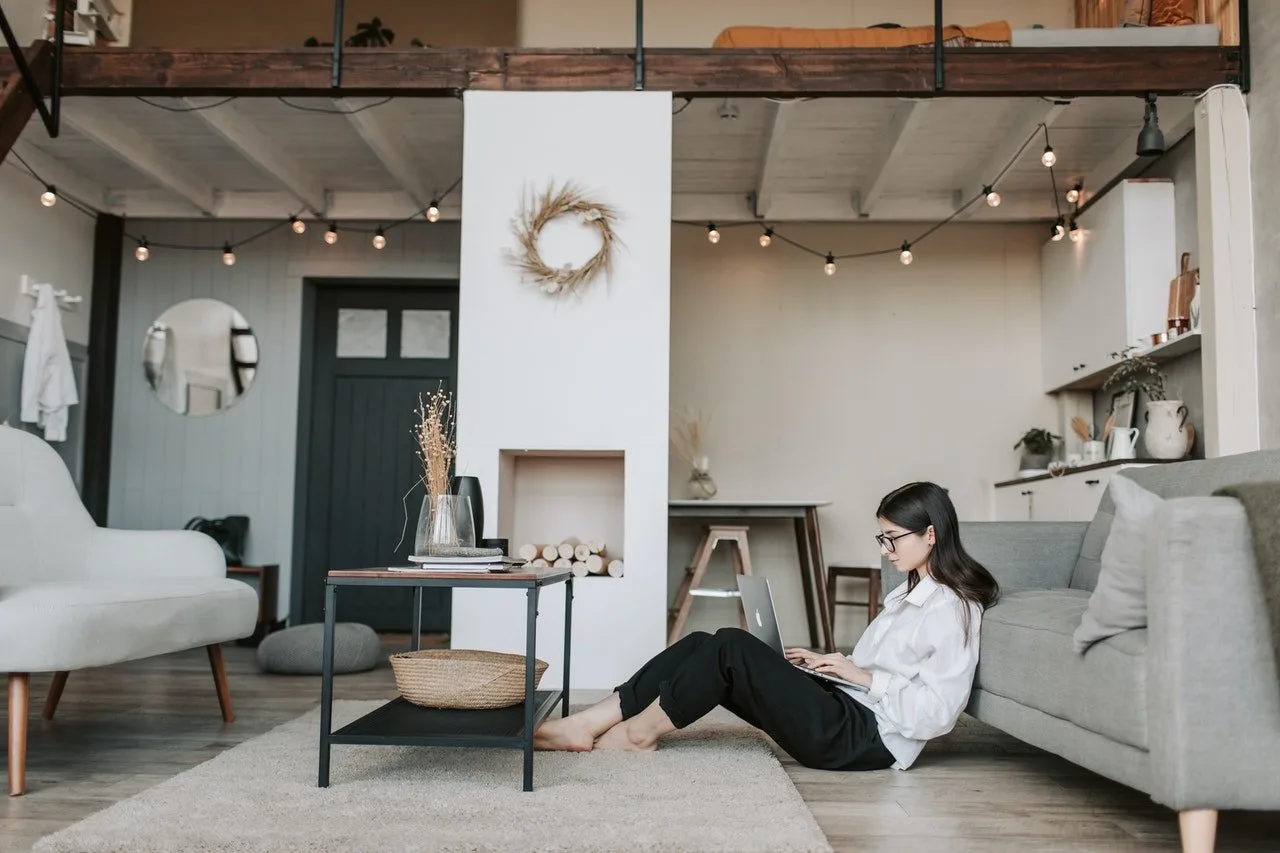For many people, working from home and remote working has its perks, well, not for all of us. For the 80% of the population that regularly suffers from back pain, working from home hasn’t been as fun.
As comfortable as our homes are, they’re not all set up for remote working and as such, many of us have resulted in sitting on our beds, sofa, or even the living room floor in order to get some work done. Unfortunately, as great as this may be for productivity, it’s really doing nothing for the state of our backs.
We’re still living through the effects of the pandemic, so you really shouldn’t add back pain to the challenges of working from home.
Don’t Let Working from Home Cause Back Pain
1. Set up your screen

Photo by Brandy Kennedy on Unsplash
With all that time you spend in front of a screen, the way it’s set up can either worsen, prevent as well as improve back pain.
When it comes to your computer screen, make sure that it’s an arm’s length away. It’s important that you’re not looking down at your screen and that it’s not at an angle where you’ll have to strain or stretch your neck.
When adjusting your screen, make sure that your eyes are aimed at the center of the screen. If you’re using a laptop, grab a stack of books or magazines and place your laptop on top of them so that it’s eye level.
Additionally, keep your keyboard and mouse close to the body so that you don’t have to reach forward.
2. Let’s talk about the chair
If you’re struggling with back pain, you need to make sure that you have the right chair. You shouldn’t be slouching or hunching over like you’re a turtle because this will just worsen the ache.
Essentially, you want to sit in a way that’s comfortable, that allows you to reach your keyboard and mouse but also provides comfort and support for your body.
If you’re sitting properly and in a way that supports your posture, your shoulders should almost be directly above the hips, your feet should be flat on the floor with your knees bent at a 90-100 degree angle and the back of your knees should be about three finger widths from the edge of the chair.
If you find that the chair is too high and nonadjustable, you can use a box, pile of books, cushion, or footrest to support your feet. Also, if you notice that the chair doesn’t support your lower back, you can roll up a bath towel or sweatshirt or grab a pillow and put it near your lower back for support.
In addition, if you have varicose veins, you can also try this method to help you elevate your legs and improve varicose veins. You may also try to consult with a varicose veins clinic located in Dallas for more information.
3. Your bed is for sex and sleep
Your bed has two jobs – to help you sleep and to help you get off, not to help you submit work reports. The fact is that your bed is not designed for you to work on it because it forces you to hunch over, and it doesn’t provide the best view of your laptop screen.

Photo by Marta Filipczyk on Unsplash
If you have nowhere else to work, there are a few ways you can turn your bed into a mini-office. One way is by putting a pillow behind your back for lumbar support and putting another on your lap and placing your laptop on the pillow.
4. Take a stand
According to a study published in Occupational and Environmental Medicine, participants who used a sit-stand desk, as well as other interventions, experienced a 50% reduction in low back pain compared to a control group that had neither intervention.
Now chances are you don’t have a standing desk at home, but that doesn’t mean you can’t use something else. Why don’t you spend your working day standing by the kitchen counter as you type out emails?
It’s important to remember that standing to work requires a lot of energy so try to exert yourself. Rather work standing up for 15 to 20 minutes every hour or two.
5. STAND UP!
Have you ever bent down to pick something up, only to hear your back crack? Well, that’s what you get for sitting on your butt all day.
A sedentary lifestyle isn’t just one of the most dangerous things for your health, but it can also worsen back pain (1).
Just because you’re working from home doesn’t mean that you shouldn’t take regular breaks and stand up. Try to do this every 30 minutes or so. You can also think of ways to incorporate movement into your day. Take a walk during a phone call or every time you finish a task, stand up and get some fresh air.
6. Exercise
It may be hard to believe but exercising is a great way to both manage and prevent back pain – it’s also much cheaper and more effective.
“More than 10 rounds of conservative treatment would still cost less than one spinal surgery,” explains Workability Quality Assurance manager and physiotherapist Demi Dreyer.
Exercise can help to support and strengthen your back muscles, and the best part is, you don’t have to leave your house if you want to break a sweat – especially with the rise of online fitness.
Exercises that can help support you if you’re struggling with back pain include bridges and yoga poses, which include bird-dog, child’s pose, and cobra.
7. Try mindfulness
According to a 2019 study, participants with chronic low back pain were asked to practice mindfulness meditation for 45 minutes per day, 6 days a week. Following training, the participants revealed a decrease in pain interference, pain intensity as well as feelings of depression. They also noted improvements in their physical function.
Mindfulness and breathing exercise aren’t only great for your mental health, but they also encourage relaxation in the body, which can ease tension and pain in the mid and lower back.

8. Stay hydrated
According to Dr. Dana Cohen, MD, author of Quench, staying hydrated can help to relieve back pain.
“The discs between our vertebra need fluid to cushion the bones,” she says. “They can become a little dry and brittle when not properly hydrated, exacerbating back pain.”
According to her, drinking plenty of water before any physical therapy is important as it can improve the outcome.

Photo by Karolina Grabowska from Pexels
Still struggling with back pain?
If you’re still struggling with back pain, then it’s important that you reach out to your doctor. They can help diagnose your pain and, if necessary, refer you to a specialist who can help you better manage your condition. If severe, you may have to undergo surgery.
“Surgical management of pain should be considered only in certain clinical presentations,” explains Dreyer. She adds that potential risks include extended time off from work, a lengthy recovery period, and an inability to engage in important daily activities.
Dreyer also adds that whilst more than 50% of spinal surgeries are successful, 36% of patients may experience recurring back or leg pain 2 years after surgery. What’s more, surgery success rates drop to 30% after a second spinal surgery, 15% after a third, and 5% after a fourth.
Therefore, if you are struggling with back pain, then it’s important that you examine all your options after speaking to your doctor.
References
Barone Gibbs, B., Hergenroeder, A. L., Perdomo, S. J., Kowalsky, R. J., Delitto, A., & Jakicic, J. M. (2018). Reducing sedentary behaviour to decrease chronic low back pain: the stand back randomised trial. Occupational and environmental medicine, 75(5), 321–327. https://doi.org/10.1136/oemed-2017-104732
Citko, A., Górski, S., Marcinowicz, L., Górska, A. (2018). Sedentary Lifestyle and Nonspecific Low Back Pain in Medical Personnel in North-East Poland, BioMed Research International, vol, Article ID 1965807, 8 pages, https://doi.org/10.1155/2018/1965807
Day, M. A., Ward, L. C., Ehde, D. M., Thorn, B. E., et al. (2019). A Pilot Randomized Controlled Trial Comparing Mindfulness Meditation, Cognitive Therapy, and Mindfulness-Based Cognitive Therapy for Chronic Low Back Pain. Pain medicine (Malden, Mass.), 20(11), 2134–2148. https://doi.org/10.1093/pm/pny273




![women [longevity live]](https://longevitylive.com/wp-content/uploads/2020/01/photo-of-women-walking-down-the-street-1116984-100x100.jpg)










